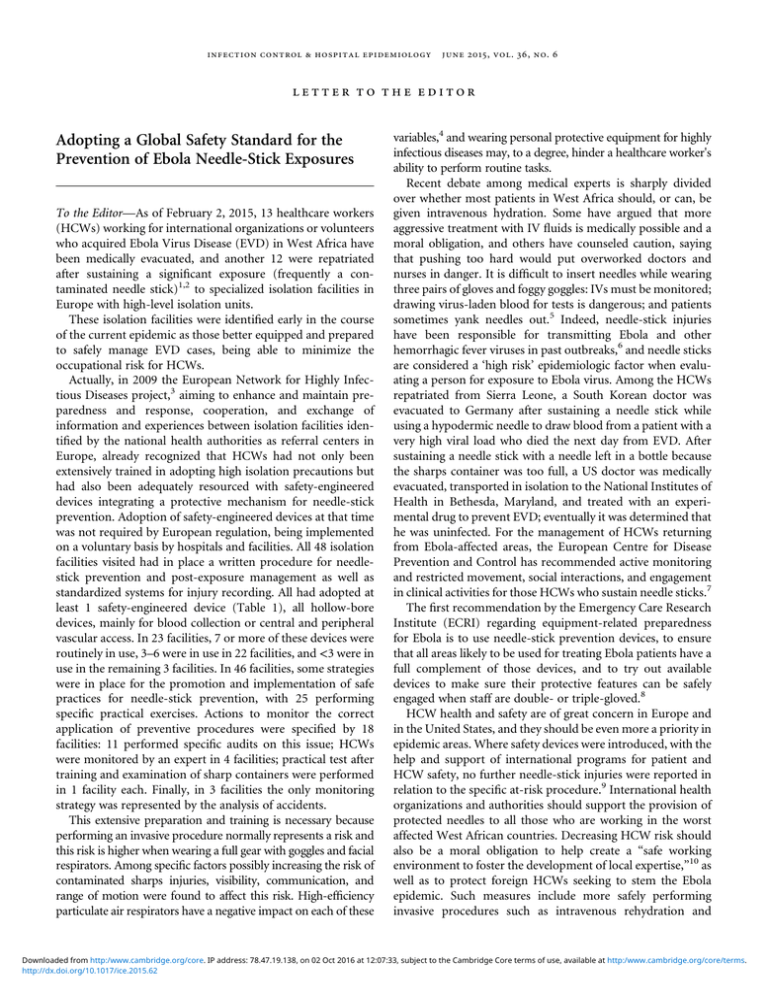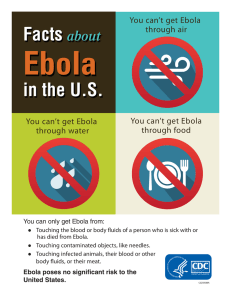
infection control & hospital epidemiology
june 2015, vol. 36, no. 6
letter to the editor
Adopting a Global Safety Standard for the
Prevention of Ebola Needle-Stick Exposures
To the Editor—As of February 2, 2015, 13 healthcare workers
(HCWs) working for international organizations or volunteers
who acquired Ebola Virus Disease (EVD) in West Africa have
been medically evacuated, and another 12 were repatriated
after sustaining a significant exposure (frequently a contaminated needle stick)1,2 to specialized isolation facilities in
Europe with high-level isolation units.
These isolation facilities were identified early in the course
of the current epidemic as those better equipped and prepared
to safely manage EVD cases, being able to minimize the
occupational risk for HCWs.
Actually, in 2009 the European Network for Highly Infectious Diseases project,3 aiming to enhance and maintain preparedness and response, cooperation, and exchange of
information and experiences between isolation facilities identified by the national health authorities as referral centers in
Europe, already recognized that HCWs had not only been
extensively trained in adopting high isolation precautions but
had also been adequately resourced with safety-engineered
devices integrating a protective mechanism for needle-stick
prevention. Adoption of safety-engineered devices at that time
was not required by European regulation, being implemented
on a voluntary basis by hospitals and facilities. All 48 isolation
facilities visited had in place a written procedure for needlestick prevention and post-exposure management as well as
standardized systems for injury recording. All had adopted at
least 1 safety-engineered device (Table 1), all hollow-bore
devices, mainly for blood collection or central and peripheral
vascular access. In 23 facilities, 7 or more of these devices were
routinely in use, 3–6 were in use in 22 facilities, and <3 were in
use in the remaining 3 facilities. In 46 facilities, some strategies
were in place for the promotion and implementation of safe
practices for needle-stick prevention, with 25 performing
specific practical exercises. Actions to monitor the correct
application of preventive procedures were specified by 18
facilities: 11 performed specific audits on this issue; HCWs
were monitored by an expert in 4 facilities; practical test after
training and examination of sharp containers were performed
in 1 facility each. Finally, in 3 facilities the only monitoring
strategy was represented by the analysis of accidents.
This extensive preparation and training is necessary because
performing an invasive procedure normally represents a risk and
this risk is higher when wearing a full gear with goggles and facial
respirators. Among specific factors possibly increasing the risk of
contaminated sharps injuries, visibility, communication, and
range of motion were found to affect this risk. High-efficiency
particulate air respirators have a negative impact on each of these
variables,4 and wearing personal protective equipment for highly
infectious diseases may, to a degree, hinder a healthcare worker's
ability to perform routine tasks.
Recent debate among medical experts is sharply divided
over whether most patients in West Africa should, or can, be
given intravenous hydration. Some have argued that more
aggressive treatment with IV fluids is medically possible and a
moral obligation, and others have counseled caution, saying
that pushing too hard would put overworked doctors and
nurses in danger. It is difficult to insert needles while wearing
three pairs of gloves and foggy goggles: IVs must be monitored;
drawing virus-laden blood for tests is dangerous; and patients
sometimes yank needles out.5 Indeed, needle-stick injuries
have been responsible for transmitting Ebola and other
hemorrhagic fever viruses in past outbreaks,6 and needle sticks
are considered a ‘high risk’ epidemiologic factor when evaluating a person for exposure to Ebola virus. Among the HCWs
repatriated from Sierra Leone, a South Korean doctor was
evacuated to Germany after sustaining a needle stick while
using a hypodermic needle to draw blood from a patient with a
very high viral load who died the next day from EVD. After
sustaining a needle stick with a needle left in a bottle because
the sharps container was too full, a US doctor was medically
evacuated, transported in isolation to the National Institutes of
Health in Bethesda, Maryland, and treated with an experimental drug to prevent EVD; eventually it was determined that
he was uninfected. For the management of HCWs returning
from Ebola-affected areas, the European Centre for Disease
Prevention and Control has recommended active monitoring
and restricted movement, social interactions, and engagement
in clinical activities for those HCWs who sustain needle sticks.7
The first recommendation by the Emergency Care Research
Institute (ECRI) regarding equipment-related preparedness
for Ebola is to use needle-stick prevention devices, to ensure
that all areas likely to be used for treating Ebola patients have a
full complement of those devices, and to try out available
devices to make sure their protective features can be safely
engaged when staff are double- or triple-gloved.8
HCW health and safety are of great concern in Europe and
in the United States, and they should be even more a priority in
epidemic areas. Where safety devices were introduced, with the
help and support of international programs for patient and
HCW safety, no further needle-stick injuries were reported in
relation to the specific at-risk procedure.9 International health
organizations and authorities should support the provision of
protected needles to all those who are working in the worst
affected West African countries. Decreasing HCW risk should
also be a moral obligation to help create a “safe working
environment to foster the development of local expertise,”10 as
well as to protect foreign HCWs seeking to stem the Ebola
epidemic. Such measures include more safely performing
invasive procedures such as intravenous rehydration and
Downloaded from http:/www.cambridge.org/core. IP address: 78.47.19.138, on 02 Oct 2016 at 12:07:33, subject to the Cambridge Core terms of use, available at http:/www.cambridge.org/core/terms.
http://dx.doi.org/10.1017/ice.2015.62
746
infection control & hospital epidemiology
june 2015, vol. 36, no. 6
table 1. Safety-Engineered Devices in Use in 48 Isolation Facilities Designated for the Referral and Management of Highly
Infectious Diseases in 16 European Countries (EuroNHID), 2009–2010
Device
No. (%)
Winged steel needle (butterfly) blood collection sets
Hypodermic needles and syringes (sliding sheath/sleeve; needle guards)
Shielded or retracting peripheral intravenous catheters
Retractable needles/syringes
Prefilled syringes
Arterial blood gas syringes
Safety engineered blood collection needles
Safety engineered blood collection needles with tube holders
Needleless jet injection systems
Needleless intravenous access – blunted cannulas
Peripherally inserted central catheter kit with integral needle protection
Prefilled medication cartridge with safety needles
Central venous catheter kit with integral needle protection
Epidural/spinal needles with safety epidural needle
37 (77.1)
30 (62.5)
28 (58.3)
27 (56.2)
23 (47.9)
22 (45.8)
22 (45.8)
22 (45.8)
17 (35.4)
17 (35.4)
13 (27.1)
12 (25.0)
11 (22.9)
6 (12.5)
constant measuring of blood chemistry, which hopefully
increase patient survival, and avoiding preventable injuries.
2.
a ck n ow le d g m e n t s
Financial support: This study was supported by grants from the European
Commission of the European Network for Highly Infectious Diseases (no.
2006205) and from the Italian Ministry of Health: Ricerca Corrente IRCCS,
and Ricerca Finalizzata 2009 (grant no. 1530527).
Potential conflict of interest: GDC and VP have developed educational material
for Becton Dickinson; FMF and GI report no conflicts related to this article.
Gabriella De Carli, MD;1
Francesco M. Fusco, MD;1
Vincenzo Puro, MD;1
Giuseppe Ippolito, MD;1
the EuroNHID Working Group
Affiliation: 1. Department of Epidemiology and Pre-Clinical Research,
National Institute for Infectious Diseases L. Spallanzani-IRCCS, Rome, Italy.
Members of the EuroNHID Working Group: Brodt RH, Schilling S, Gottschalk R, Maltezou HC, Bannister B, Vetter N, Kojouharova M, Parmakova
K, Skinhoej P, Kronborg G, Siikamaki H, Brouqui P, Perronne C, Lambert J,
Hemmer R, Borg M, Azzopardi CM, Brantsæter AB, Fjellet AL, Horban A,
Strle F, Trilla A, De Iaco G.
Address correspondence to Gabriella De Carli, Infezioni Emergenti e
Riemergenti e Centro di Riferimento AIDS, National Institute for Infectious
Diseases, L. Spallanzani-IRCCS, Via Portuense 292, 00149, Rome, Italy.
(gabriella.decarli@inmi.it).
Infect Control Hosp Epidemiol 2015;36(6):745–746
© 2015 by The Society for Healthcare Epidemiology of America. All rights
reserved. This is an Open Access article, distributed under the terms of the
Creative Commons Attribution licence (http://creativecommons.org/licenses/
by/3.0/), which permits unrestricted re-use, distribution, and reproduction in
any medium, provided the original work is properly cited. 0899-823X/2015/
3606-0022. DOI: 10.1017/ice.2015.62
3.
4.
5.
6.
7.
8.
9.
references
1. Epidemiological update: Outbreak of Ebola virus disease in West
Africa 30/01/2015. European Centre for Disease Prevention and
Control website. http://www.ecdc.europa.eu/en/press/news/_layouts/
10.
forms/News_DispForm.aspx?List=8db7286c-fe2d-476c-9133-18ff4c
b1b568&ID=1160. Published 2015. Accessed January 31, 2015.
Public Health England. Second healthcare worker transported to UK
for Ebola monitoring. Precautionary action taken, 2 similar incidents
are unrelated. United Kingdom government website. https://www.
gov.uk/government/news/second-healthcare-worker-transportedto-uk-for-ebola-monitoring. Published 2015. Accessed February 13,
2015.
Ippolito G, Puro V, Brouqui P, Lauria F, Fusco F; EuroNHID
Consortium. Letter to the editor: Management of patients with
Ebola virus disease in Europe: high-level isolation units should
have a key role. Euro Surveill 2014;19:20993.
Eck EK, Vannier A. The effect of high-efficiency particulate air
respirator design on occupational health: a pilot study balancing risks
in the real world. Infect Control Hosp Epidemiol 1997;18:122–127.
McNeil DG Jr. Ebola doctors are divided on IV therapy in Africa.
The New York Times, January 1, 2015. http://www.nytimes.
com/2015/01/02/health/ebola-doctors-are-divided-on-iv-therapyin-africa.html?_r=0#story-continues-1. Published 2015. Accessed
February 13, 2015.
Tarantola A, Abiteboul D, Rachline A. Infection risks following
accidental exposure to blood or body fluids in health care
workers: a review of pathogens transmitted in published cases.
Am J Infect Control 2006;34:367–375.
Technical report: Infection prevention and control measures for
Ebola virus disease. Management of healthcare workers returning
from Ebola-affected areas. European Centre for Disease Prevention and Control website. www.ecdc.europa.eu/en/publications/
Publications/Management-HCW-return-Ebola-affected-areas.pdf.
Published 2015. Accessed January 31, 2015.
Guidance. Checklist: equipment-related preparedness for Ebola. Emergency Care Research Institute website. https://www.ecri.org/compo
nents/HDJournal/Pages/Checklist-Equipment-Related-Prepared
ness-for-Ebola.aspx. Published 2014. Accessed January 31, 2015.
Rouveix E, Madougou B, Pellissier G, et al. Promoting the safety of
healthcare workers in Africa: from HIV pandemic to Ebola epidemic. Infect Control Hosp Epidemiol 36. doi:10.1017/ice.2014.68.
Bausch DG, Sesay SS, Oshin B. In Memoriam, Aniru Conteh,
1942–2004. On the front lines of Lassa fever. Emerg Infect Dis
2004;1:1889–1890.
Downloaded from http:/www.cambridge.org/core. IP address: 78.47.19.138, on 02 Oct 2016 at 12:07:33, subject to the Cambridge Core terms of use, available at http:/www.cambridge.org/core/terms.
http://dx.doi.org/10.1017/ice.2015.62


